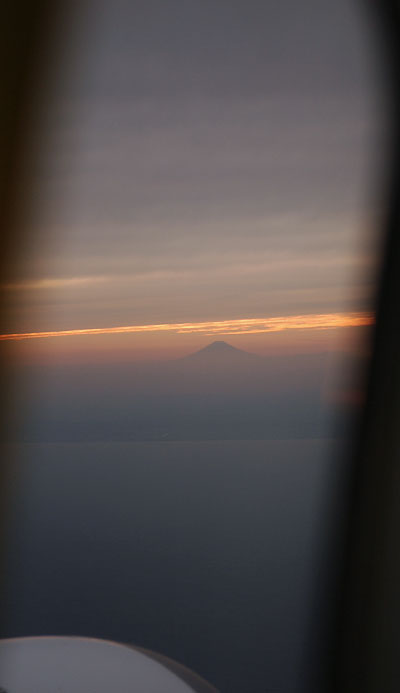 Here’s a change in perspective that slapped me in the face today. I was walking through Jimbocho and passed by a “vintage goods” shop full of Rolleiflex cameras, Zippo lighters, and Omega watches. What shocked me were the two neon green and orange plastic Swatches from the early 80s.
Here’s a change in perspective that slapped me in the face today. I was walking through Jimbocho and passed by a “vintage goods” shop full of Rolleiflex cameras, Zippo lighters, and Omega watches. What shocked me were the two neon green and orange plastic Swatches from the early 80s.
Could 1984 possibly be vintage? Antique? Oh,please…no!
I spent the rest of my walk pondering the concepts of old, antique and vintage. What do I think of as antique? Certainly any thing older than the 40s qualifies. Stuff from the 50s were my parents’ things growing up so some of them were in my childhood home. They were old, but not antique. Certain items from the 60s seem antique—mainly things that I use the modern equivalent of today: 1960s computers are antiques. Anything from the 70s forward, though, I can’t classify as vintage.
It boils down to “anything older than me” is antique. Things that existed from the time I became cognizant of the world simply are not old enough to be antiques. I imagine that this will hold true even when I am 100.
Those Swatches will never be antiques. But they will always be tacky.
I don’t think I necessarily seek to include either the modern or the ancient in my creative work. But I do rely on places, people and things that influenced me growing up and as an adult. That means that people older than me have a much richer selection of influences and that I have more depth to draw from than a teenager.
So what’s antique or old to you? Do you think that your childhood “contemporania” influences your art and creativity?
RFID (radio frequency identification) tags are used by warehousing and large retailers to track their stock; the tags are programmed with all kinds of information and identify themselves automatically to any tag reader in the vicinity.
RFID is also used for livestock tagging and in corporate ID badges. In Mexico, the attorney general’s lawyers have had RFID tags implanted so they can be tracked in case of kidnappings.
And now Rikkyo Primary School in Tokyo has jumped on the RFID bandwagon in the interest of school security. From April next year, students will have RFID tags pinned to them to monitor their entry and exit from the building. Although it seems benign on one level, don’t you think it’s a little bit too Big Brother? And will it extend from the doorway to a more thorough monitoring?
“Where’s little Ko-chan?” teacher asks.
“In the toilet. Stall three. Been there for….2 minutes 46 seconds,” replies the school monitor.
Will these children, along with the countless adults who have RFID implanted or tucked into their wallet, get so used to being tracked that they won’t consider it an invasion of privacy?
Sorry, but I’m not going there. no RFID for me, thank you very much.
Fireworks festivals are not normally held in October but this one in Tsuchiura, Ibaraki prefecture, is an exception. It’s a competition and showcase of nearly 100 “grand finales” and new models of colorful explosions.
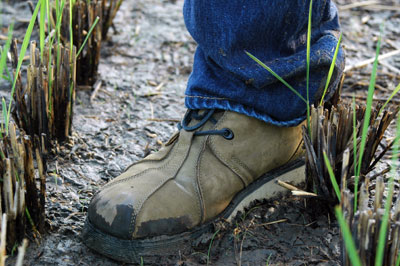
Seating was in a muddy rice paddy, freshly harvested.
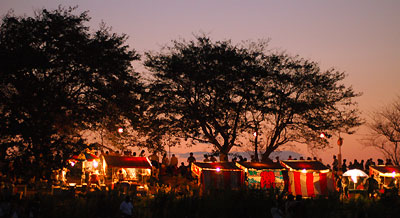
As the sun set the food stalls lit up but our group of twelve didn’t indulge. We brought a picnic feast of homemade pizza, lamb chops, lasagne, oden, Taiwanese eggs, side dishes galore, cakes and lots of drinks.

The finales were bright as day.

The combination of colors and shapes delighted me. I grinned for the entire two hour show.

Jim, eschewing the usual (as usual), took black and white photos.
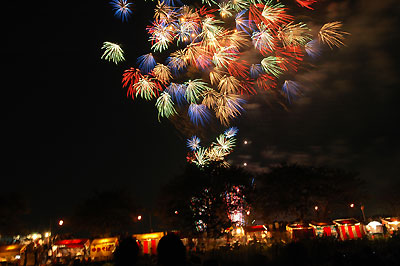
This patchwork of small explosions quilted the sky.
Once again, I modelled for the CEATEC convention posters. On last year’s poster, I wasn’t easily identified—you could see my tattoo in one shot and I was a tiny black spec at the bottom of an escalator in another.
Last night, I faced my photographed self in Shinjuku station. On this year’s poster I found my smile, my profile and my full body.
It was disconcerting, delightful, and slightly uncomfortable to see myself in such a well-travelled public place—sort of like having my name published on an article. Thankfully, the photos are small; I hope this doesn’t count much towards the elusive 15 minutes.
CEATEC begins tomorrow and runs only a few days, so if you want to scope out the poster, you’d better hurry. Walk down the Metro Promenade on B2F in Shinjuku station towards the Marunouchi line. The poster is on a bulletin board not far past the row of shops in the promenade.
Take a pen and draw in a mustache and devil horns. You know you want to…
I bought a soap the other day that smells so good, I keep walking into the bathroom to sniff it.
It bills itself as a lavender soap but the fragrance is really the scent of the middle drawer in my desk when I was 9. Pencil shavings, postage stamp glue, rubber bands, library paste. Neglected homework.
Who makes soap that smells so academic? It’s Lush’s Ohh La La. Reading through the ingredient list, I see no pencil shavings, but I do find thyme (my favorite herb), rosemary and lots of lavender. Plus the grape juice that makes it run vivid fuschia when wet.
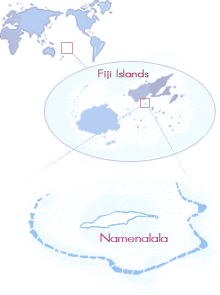 I’m about to hand over a wad of cash for some airplane tickets to Fiji. We leave tomorrow.
I’m about to hand over a wad of cash for some airplane tickets to Fiji. We leave tomorrow.
Moody’s Namena is a tiny island resort where Tod & I will swim among the fishes, hike through the tropical forest, and lounge in hammocks while we read books. For some people, this would be a terribly dull holiday. But not for me. I’m packing art supplies, star charts, a bathing suit and not a whole lot else. Aaaaaah!
Which is all by way of saying there won’t be any updates here for a little while, but I promise to backfill with photos of sand, sun and etc. as soon as we return.
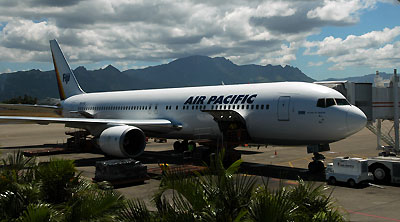
Air Pacific flies direct Tokyo to Nadi every day.
Getting there is not really half the fun. It’s not really much fun at all.
Traveling to Namena from Tokyo is quite a trek. An 8 hour “red eye” flight to Nadi on Air Pacific, Fiji’s national airline. Follow this by an hour on a tiny plane to Savusavu. Then a 90 minute boat trip across 25 miles of choppy sea to Namena’s dock.
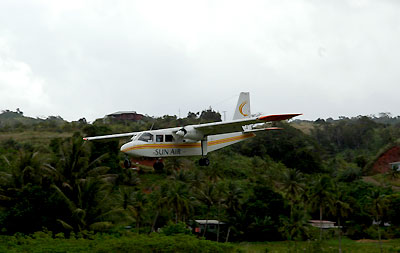
This Sun Air plane was like a minivan with wings.
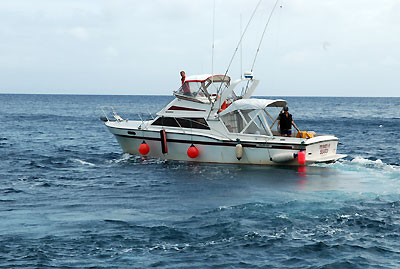
Transstar Charters, owned and operated by Terry and Davina, was the final leg of the trip to Namena.
I was exhausted, even though we weren’t doing anything but sitting and waiting. We arrived safely after about 15 hours of non-stop “getting there” and settled in for a week of “being there.”
Namena was uninhabited 20 years ago when Tom Moody signed a 99 year lease from the native land board. In fact, namena means uninhabited in Fijian.
These days, Namena is lightly inhabited. Tom & Joan Moody live there year round, along with 12-18 staff (depending on how busy the resort is) and no more than 12 guests.
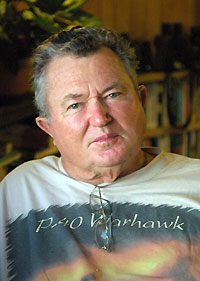

Tom & Joan (pronounced Jo-ann, I kept embarrassing myself by forgetting and calling her Joan) are native Pittsburghers, but have lived outside the US for over 40 years. They founded a posh resort in Panama in the 70s, but were chased out in a horrific incident in 1991 that ended with Tom in the hospital for two months and the resort abandoned in haste. Undaunted, they started over and after scouring the South Pacific, found Namena.
Tom’s 76 now, and starting to slow down a bit (the shooting in Panama didn’t do him any favors) but he was a motorcycle hellion and an avid diver back in the day so he has a lot to slow down from! He has more stories and tales than anyone I’ve ever met. Tom spends his days directing improvements and maintenance and enjoys meals with the guests.
Joan manages the business end of things. She’s got a computer, runs the communication systems, handles reservations and local transfers to the island, and has a lot of connections around Fiji. Joan took her meals away from us, as she was suffering a cough and didn’t want to infect the holidaymakers. So we didn’t get to spend too much time with her, but I think she has nearly as many stories as Tom!
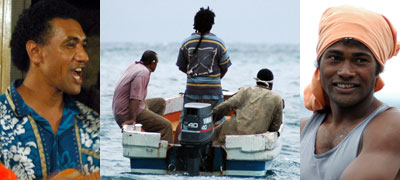
Jone plays ukulele; M’bola flanked by two “boat guys”; Victor the dive master
The staff are fabulous. Tom calls them kids, but they’re not really all that young. Jone (pronounced Johnny) is the “waiter” and seemingly uncle to most of the rest of the staff. The three girls on staff are sisters and Jone’s nieces. Everyone else is a cousin in some fashion. Which is good, because this working family doesn’t get off the island too often. They have to get along or they’d be miserable.
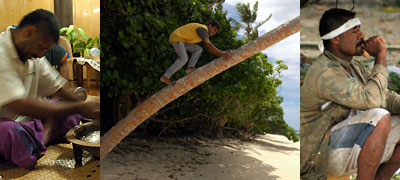
Cook mixes up some kava; Vijay nimbly scales a coconut palm; a “boat guy” watches the dock.
Despite the fact that we were there for a week and there are only 12 people taking care of us, I still didn’t learn everyone’s name. Victor is the cheeky dive master. Don drives the boat. M’Bola and Vijay do everything that’s required—from loading boats to leading the guests on jungle treks. Benny’s the kitchen boy who is a great dancer and has a shy smile. There is also a cook and several “boat guys” seemed to hide behind the scenes to get things done.
And of course there were other guests on the island. Our stay was divided neatly into two sections by the departure and arrival of guests. Everyone we met was memorable and interesting.
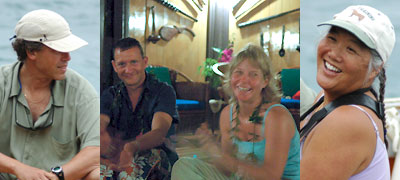
Bradley on the launch ready to leave; Mike and Kim enjoying kava; Nancy on the launch.
The first group was two diving couples: Nancy and Bradley from Santa Cruz, and Mike & Kim from Auckland. Mealtime conversations were lessons in oceanography, conservation and diving lore. I am keen to learn to dive now.
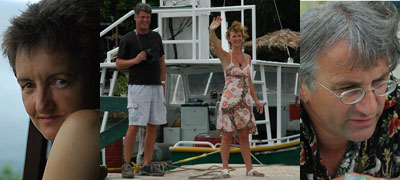
Deborah in the window at sunset; Sara and Jerry wave goodbye to us; Gerard contemplates departure.
They left on Monday and Tuesday and were replaced by Sara and Jerry, married filmmakers from Melbourne who were decompressing after the Athens Olympics, and Deborah and Gerard from New Zealand who were there to work (!) gathering material for a program for Radio New Zealand and an article, respectively. We talked world politics and a little shop over dinner.
People have rarely figured so prominently in my holidays. I enjoyed it very much. Namena’s remoteness attracts unusual travelers.
Moody’s Namena was a deserted island 20 years ago. Every man-made thing that exists on the island has been brought by boat, hauled by men up a steep hill and assembled by hand.
Supplies and mail arrive with the guests on the boat or in the sea plane. Namena have a small cargo boat (the generous gift of a wealthy guest) that makes the journey to Savusavu for fuel, tools, supplies, and food.
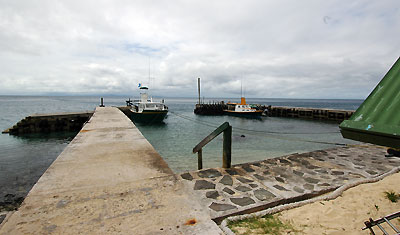
Namena’s dock.
We were greeted at a concrete dock (the original dock was blown away during a cyclone shortly after it was built) and taken up to the top of the island in Tom’s Polaris utility vehicle. They built the roads just five years ago. Before that everyone made the trip up and down 106 wooden steps.

Inside our guest house; a view from the veranda.
The guest houses, called bure in Fijian, are hexagonal structures of wood beams (telephone poles carried by hand up the hill before the stairs were built) and boards. They feature high ceilings, doors on four sides that open to a wrap-around veranda with ocean and forest views, and wooden floors made of a tree related to rosewood that is no longer logged. There is no electricity—we lit gas lamps in the evenings, and read in bed by the light of solar powered lights. Water is collected when it rains and gravity fed to sink and shower. The toilets use salt water. Each bure has a gas burner and kettle for making tea, two generous closets, built-in desks and a mosquito-netted bed. What more could you need? I wanted for nothing.
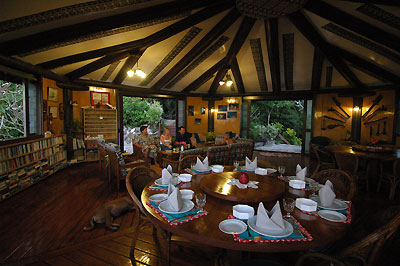
Guests get together for meals in the clubhouse
Meals are served in the clubhouse, constructed like the bure, but on a larger scale. A gas powered fridge supplies ice and keeps the mixers cool (bring your own booze from the duty free). Two round tables seat six people each and there are comfy chairs drawn up neatly around a large coffee table littered with reef identification books. Bookshelves line two walls under the large picture windows which are glassless to allow the breezes to flow through. Birds sometimes fly through, too.
An adjoining kitchen and office, a boat house near the dock, and the staff quarters at the other end of the complex complete the buildings on the island.
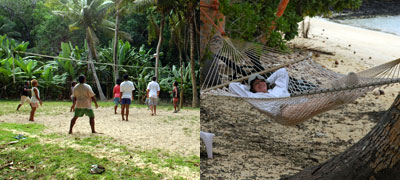
Staff outnumber guests on the volleyball court; I’m resting!
Down at one of the beaches, there’s a grassy volleyball court, some hammocks, and a barbecue area. Trails crisscross the island for hikes from head to tail of the dragon.
That’s about all on the island that’s been touched by man. Tom designated 10% of the land as “developed” and leaves the rest wild. Nothing is off-limits at Namena; guests have the run of the place.
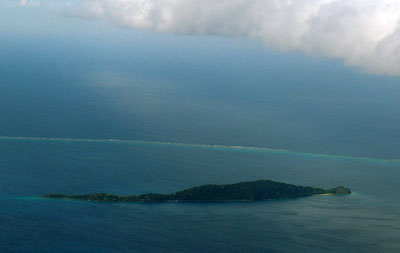
Namena from the air
The island is shaped like a mile-long dragon—a triangular head towards the west, a lumpish body in the center and a long sloping tail pointing east. There are three main beaches with smaller beaches and rocky coastline accessible at low tide. The north is the leeward side, facing the distant island of Vanua Levu, where we started our sea journey. To the south, you can see the even more distant islands of Koro and the former leper colony of Makogai.
Namena wasn’t always uninhabited. There was once a small tribe living there. Tom estimates the island would have supported about 18 people. There is rocky fortification built on the highest point of the island. It affords good views to the sea towards the only opening in the reef. There are several round wells or fire pits built along the hill. Where the volleyball court is not, was once a village. Tom and the men have found scores of pottery shards and other artifacts there and had them dated to 2000+ years old.
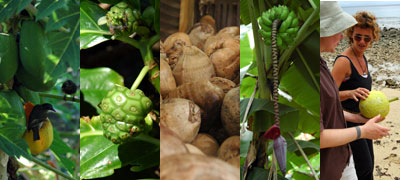
Birds enjoy a ripe papaya; the mysterious medicinal noni; coconuts in storage; bananas; Sara and I examine a fresh breadfruit.
Namena has numerous native food plants. We enjoyed the island’s produce of papaya, coconut, breadfruit, and bull’s heart along with some delicacies Tom imported—bananas, pineapple and Joan’s delicious tomatoes. There’s a vine-y pepper that grows like a weed, pandan (which Fijians don’t eat, though other islanders do), and noni, a medicinal fruit that smells like stinky French cheese when it’s ripe.
I was surprised at how familiar the island’s jungle looked. Aside from the vines, it could have been Mt Takao or the hills of Pennsylvania. There were deciduous trees, jutting rocks, and shrubby undergrowth. My idea of jungle was shattered.
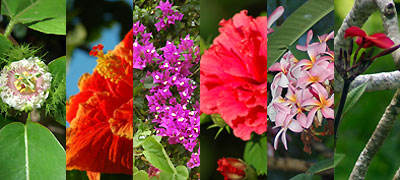
A jungle vine; hibiscus; borganvillea; a viciously red flower; frangipani; tiara
Flowers are Fijians favorite decoration and for good reason. Bougainvillea, frangipani, hibiscus, and tiara grow in abundance. Outside our bure was a stalky varigated plant with red flowers that the honey catchers liked to visit.
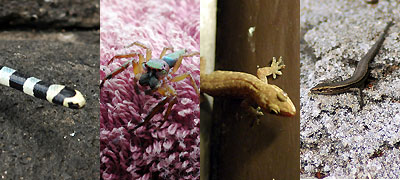
A poisonous seasnake; the spider that jumped on Tod’s nose; a gecko; a blue-tailed skink.
There’s not a lot of fauna on the island, aside from birds (see tomorrow’s entry). We encountered a venomous sea snake, lots of geckoes and blue-tailed lizards, and a rat.
There are plenty of hungry mosquitoes, which contrary to our expectations, are active during the day. Moths and butterflies flutter around. Spiders, pale brown crickets, beetles large and small, and jillions of ants make up the remainder of the island insects.
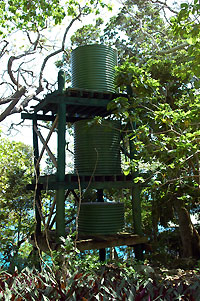 One thing that Namena lacks is fresh water. All the water we drank on the island was rainwater. And Namena doesn’t get a lot of rain, so you want to be conservative in your use.
One thing that Namena lacks is fresh water. All the water we drank on the island was rainwater. And Namena doesn’t get a lot of rain, so you want to be conservative in your use.
An Australian man who came to Namena after WWII to try to recover from his shattering war experience lived on the island for a few months and dug a clever system of channels in the rock cliffs to route rainwater into a holding basin. Tom says that when he first arrived on Namena and camped out to explore the land, he discovered the excavations, cleaned them out and found them quite effective for collecting water. But these days he uses metal and plastic tanks for his water system.
Tod delighted in photographing birds. And there were many to choose among.
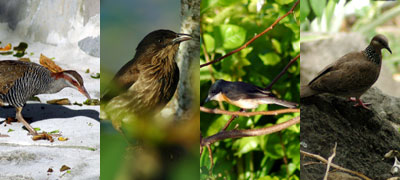
Banded rail; Pacific starling; unidentified little bird; spotted dove.
Around the bures we saw banded rails including three fuzzy black chicks, swifts, white-collared kingfishers, orange-breasted mylomeza (honey catchers), Fiji white-eyes, Pacific starlings, spotted doves, friendly ground doves, and the pesky mynahs that migrated from a passing ship and are eating all the white-eye eggs.
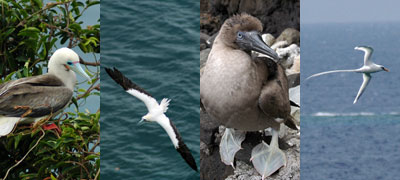
Red-footed booby; masked booby; baby booby; white-tailed tropicbird.
Over the sea we watched frigate birds chasing the boobies. There are red-footed boobies, masked boobies and brown boobies nesting on Namena. Terns skimmed the water and a reef heron appeared on the rocky shores from time to time. A magnificent white-tailed tropicbird flew around our bure.

At sunset we watched for the green flash and for the flying foxes. These beautiful bats have a wingspan of about a meter. They are huge and they feast on fruits.
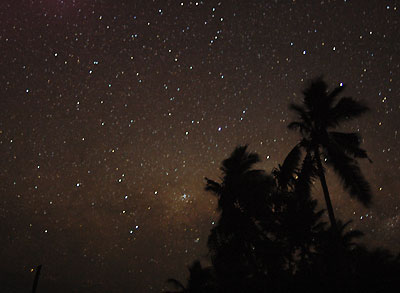
Looking towards Scorpius and Corona Australis.
After the birds and bats had gone to bed, the stars appeared. Only one night of our stay was perfectly clear, but we took good advantage of it. After dinner we carried the camera, tripod, start charts and laser pointer to the beach for some fun. The Milky Way was bright across the sky. I saw nine shooting stars in the two hours we were on the beach.
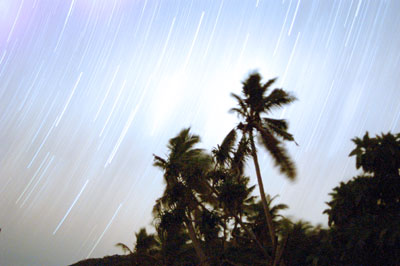
The stars move quite a bit in 30 minutes!
I was so excited to see the southern constellations for the first time. We didn’t stay up late enough (or get up early enough) to see the Southern Cross, but I identified Grus, Pavo, Eridanus, Horogulum, Triangulum Australe, Scorpius, and Corona Australis. We took one 30 minute exposure (too long really, as it’s too bright) to capture the star trails around Scorpius.

The Magellanic clouds.
I was perplexed by two hazy patches due south. They weren’t part of the Milky Way and they weren’t clouds in the sky. A little research revealed that they are the Magellanic Clouds—galaxies in our own astronomical neighborhood.
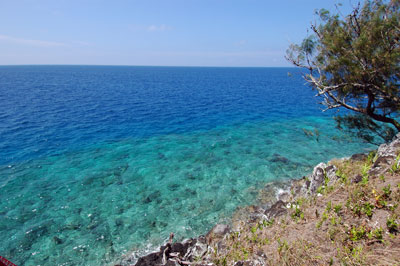
The island is surrounded by a coral reef and so has a plethora of fishes and underwater wildlife. The water is turquoise over the reef and bommies and it is as clear as the sky.
The reef is a protected marine reserve, thanks to Joan’s intervention. All divers have to buy a $20 “reef tag” that gives them permission to dive. The money goes to maintaining the reef environment and to scholarships for the children in Savusavu.
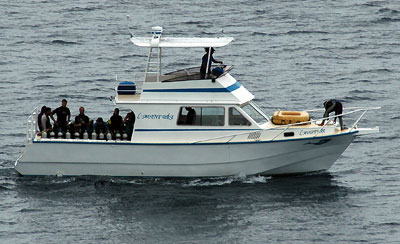
Divers on boats like this one dive up to six times a day; that’s bad for the reef.
Joan had petitioned the government for protected status for their reef, to no avail. One of her friends who works for the UN dismissed her attempts at conservationism. “You won’t be able to do it,” he advised. That got Joan’s Sicilian blood pumping and she initiated a grassroots effort by the local islanders. “I told our men, ‘Go tell your fathers, your brothers, your uncles that the reef is being overfished and destroyed. This is your land, your heritage. You should preserve it.’” And it worked.
So what are they preserving? An astonishing array of fish—particolored parrotfish, surgeon fish with long snouts, puffers, damselfish, sardines, and dozens of others. I saw sleeping reef sharks and just missed a glimpse of a manta—Vijay pointed it out but it moved too quickly! There were so many fish I can’t keep track of them all, though I tried to look up the ones I remembered in the reference books in the lounge.
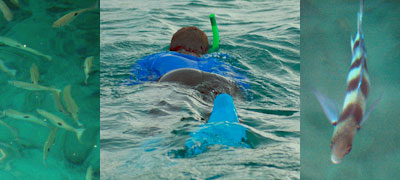
School of yellowish spotted fish; me snorkeling; striped fish of unknown type.
We only snorkelled out at the reef one afternoon, but spent time in nearer the island gawking at the underwater beauty. Even near the dock there were schools of colorful fish and live corals in vivid blue and pale purple, swaying orange tendrils, big expanses of green-grey swirls. The ocean is better than a paintbox.
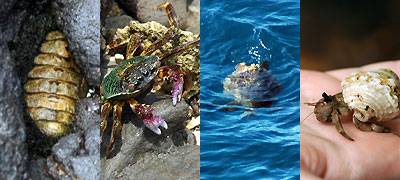
A chiton, formerly prized for jewelry; green shore crab; our shy turtle firend; a hermit crab.
Close to the shore we saw sea snails, chitons, anenome, starfish, hermit crabs (Tod’s favorite) and brilliant green shore crabs. Blennies hopped around in the tide pools. Turtles migrate to nest on the island and we saw one of the three resident turtles swimming around our bure one afternoon.
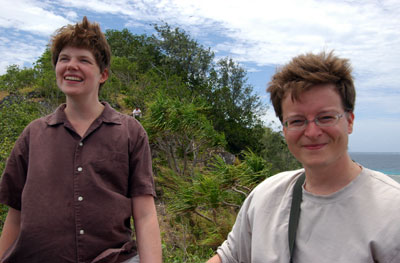
Us on the head of Namena’s dragon. (Photo by Deborah Nation)
Our excuse for visiting Namena was to celebrate our 15th wedding anniversary. We wanted a relaxing week away from the busy city. It proved to be so leisurely and laid-back that I nearly forgot our anniversary.
I could have sworn the 13th was on Thursday. I was so sure of it that on Wednesday I was writing out postcards and dating them 12 October. But Wednesday evening, as we gathered for pre-dinner drinks in the clubhouse, Tod looked at the handwritten chart of tides which carried the date as well as the tidal hours. He raised his glass and wished me a happy anniversary. What a surprise!
The next night, we all celebrated with a bottle of champagne and a toast to happy relationships at dinner. The staff brought out a cake with candles, luscious tiara flower garlands, and a gift of Fiji-made frangipani bath products. They serenaded us with ukulele, guitar and voice. We danced and my sulu (the traditional wrap around skirt worn by men and women) nearly fell off. Tom joked that I needed a staple gun.
Thanks to everyone for making our nearly forgotten 15th so completely memorable!
 Fijian cooking is influenced by the island produce and fish. Kokoda is a citrus-pickled fish in spicy coconut sauce. It makes a great appetiser. Here it is:
Fijian cooking is influenced by the island produce and fish. Kokoda is a citrus-pickled fish in spicy coconut sauce. It makes a great appetiser. Here it is:
Kokoda
serves 2
1 filet firm white fish (walu, tuna, swordfish)
juice of one lime
juice of one lemon
1/2 small onion, minced
1/2 green pepper minced
1 green or red chile, minced
1/2 can coconut cream/milk
salt & pepper to taste
Cut the filet into 1 cm cubes. Soak in the lemon and lime juices for 2 hours to pickle the fish. Rinse the juice off. Mix the fish with the remaining ingredients. It’s fine to eat immediately, but refrigerate a few hours more, or overnight, for best flavor.
If the fish doesn’t pickle all the way through (if you cut it to large like I did yesterday), you can convert this into a tasty fish curry by bringing it to a simmer and heating for about 10 minutes.
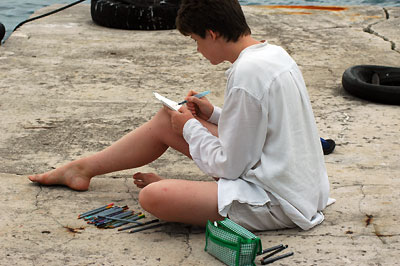
Drawing on the dock.
While Tod snapped 733 photographs (I thank him for the illustrative materials in the previous week’s entries!), I spent my time sketching. I wasn’t quite so prolific, but I managed almost 2 dozen drawings.
Near the end of our stay, Jone was peeking over my shoulder watching me sketch the clubhouse window and bookshelf, I think it was. So I invited him to draw with me the next afternoon during his break. He and I sat outside and drew flowers. I showed him how to use the watercolor pencils I’d brought along. Soon we were joined by Benny, Maria and her sisters. It was really fun to watch them work. Benny drew a fabulous leaf. The girls drew flowers on the bushes around us. They are all very natural artists.
Jone has an untapped gift. His watercolor of hibiscus showed a delicate touch and a good eye. It was every bit as good as mine and he swears he hasn’t drawn before. I was so pleased! We gathered again the next day. “We should have started this sooner,” he commented. He was so delighted with drawing that I left the pencils, brush and the remainder of my watercolor paper for him.

Tapa patterns on cloth in the clubhouse.
There are traditional geometric patterns laid out in lines called tapa that are used in textiles and as decorative elements. They pop up everywhere on Namena—the bed canopies, the ceilings, the table mats, even the battle hammers that decorate one wall. I spent a lot of time examining them.
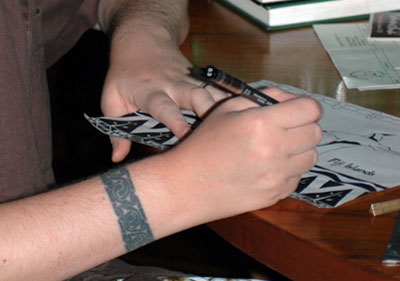
The sulu design in progress
So when Joan asked if I would draw them a logo to use for their new sulu and t-shirts, I incorporated tapa into the design. Moody’s Namena have a tropicbird as their mascot, so the bird flies over three rows of tapa: one neat geometric that Benny likes from the fabrics in the clubhouse; one of my own design that symbolises the plants on the island (and the male/female triangle symbols since I’d just finished reading The Da Vinci Code); and a wave pattern on the top so the bird soars over the ocean. I was pleased with the result; Joan loves it and gave me a big hug when I presented it to her. I’m happy that a little bit of me will be on Namena for a while.
In mid-July I ordered a new dual processor PowerMac G5. Just the thing for editing video—a lot of power in one box. I also splurged (after a bit of debate with Tod) and bought the 30” Cinema Display.
Delay, excuse, delay, excuse, delay…but it finally arrived today.
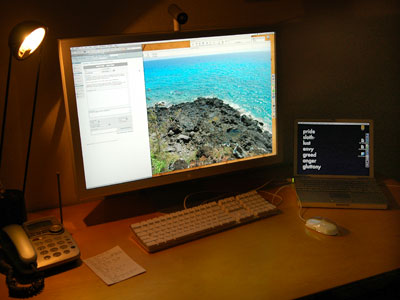
I will never have to scroll my timeline ever again. This monitor is just humungous. It going to take a little while to figure out where to focus my eyes and how to arrange my application windows to use screenus maximus.
 If you wanted to see more photos (or full-size versions) of Moody’s Namena, check out the 728 shots Tod snapped during our vacation. They are unedited so you’ll see the good, the bad and the ugly—I even left the ones in where I look fat and dorky.
If you wanted to see more photos (or full-size versions) of Moody’s Namena, check out the 728 shots Tod snapped during our vacation. They are unedited so you’ll see the good, the bad and the ugly—I even left the ones in where I look fat and dorky.
If you’re reading mediatinker via a newsreader, you’ve may have missed the extended version of my backfilled week of Namena posts which include more stories and pictures. So please click through and have a look; it’s such a fabulous place, I hope you won’t want top miss anything.
It’s embarrassing that my formerly fine and upstanding nation is having its election monitored by the organizations that oversee elections in places like Bosnia, Kazakhstan and Afghanistan. Even US citizens are getting into the monitoring act. The level of trust in the system is low.
IHT: European monitoring group to observe U.S. election
Portsmoth Herald: Monitoring the Nov. 2 election
Mathaba: A Clean Count?
Deutsche Welle: Monitors Criticize US Election Procedures
Some of my friends here in Tokyo are going to Florida to keep an eye on things on election day. They’ll be armed with video cameras and cell phones to alert everyone of any problems.
“Sunshine and Gators” is hoping to raise a little more money to fund their flights and equipment costs. If you’re up for a good time for a good cause, why not nip over to Nishi-Azabu tomorrow for a Halloween party?

Bush is Scary, Vote for Kerry
Wednesday, 20 Oct, from 7:00 PM
SuperDeluxe
3-1-25 Nishi-Azabu, B1F
Admission is 3000 yen, all going to the “Sunshine and Alligators” activists to cover transportation, vehicle rental, cell phones and other expenses. Live music, DJs, costume contest, door prizes, good food
For more details see www.sunshineandgators.com.
My friends will back me up on this: I’d rather type than talk. I can count on one hand (minus the thumb) the number of people I will willingly and gladly phone. Everyone else gets me in e-mail or chat. I’ve been using real-time chat for so many years that I no longer see much difference between typing and talking. It’s all communication to me.
This short film shows what too much IM can lead to. I wish I’d made this one, but I was beaten to the punch by three clever guys in Winnetka, Illinois—Picture Show Films.
Instant Mess (streaming Quicktime)
 2004 is the UN’s International Year of Rice. Rice supports half the world’s population. Yeah for rice!
2004 is the UN’s International Year of Rice. Rice supports half the world’s population. Yeah for rice!
I lived on mainly rice during my junior year at university in PIttsburgh. I had my first apartment and not much money. Rice was the cheapest staple in the grocery store and I discovered how versatile it is. I was creative with combinations of rice, eggs and milk for breakfast, lunch and dinner. Here’s one of my favorite frugal treats—usually made with the rice leftover from a rice omelet or plain fried rice.
Simple Rice Pudding
serves 2
1/2 cup cooked rice
2 cups milk
2 eggs, very well beaten
2 or 3 Tbsp sugar
optional: cinnamon, raisins, grated apple, and/or black pepper
Heat the milk (do not boil) and add the rice, stirring to separate. Stir in the sugar. Whisk in the eggs. Add any additional seasonings you desire.
You can either cover the pot and continue cooking over very low heat until the milk and eggs form a soft custard (about 30 minutes to an hour), or put the pot in the oven (if it is oven-safe) and bake at 300 degrees for an hour or so.
Can be served warm or cold.
 My darling husband asked me the other day “If you could start a religion, what would it be like?”
My darling husband asked me the other day “If you could start a religion, what would it be like?”
Oh, interesting thought experiment. I let the ideas rattle around in my brain for a few minutes, dismissing thoughts of lofting stone chapels with velvet draperies and deep pipe organ tones, then started churning out my ideas.
Reverence for nature
Respect for inexplicable phenomena
Veneration of creative practices
Celebrations for no real reason
Love of highs, lows, and balance
Adoration of sexual arts
Points off for consumerism
Double points off for car owners
As I wound up the litany of observances, he turned to me, smiled, and said, “Mine would be the Cult of the Cherry Ripe.” Heh.
So I put the question to you: what would your religion be like?
Recently, a friend asked me to give her some tips on creating menus for restaurants (though how she knew that this is something I’ve done I don’t quite know). I wrote up a few short e-mail lessons that I thought I’d present to you. You never know when you’re going to be called on to write a menu!
Introduction
You already know that all menus are divided into sections: appetisers/starters, salad/soup/sides, main dishes (sometimes divided by type of meat used or whether its pasta/rice/meat), desserts and drinks. I’m sure that’s not something you need any instruction on.
Something that I probably can’t help you with too much is food knowledge. A good knowledge of food is important to be able to write menus. What’s the difference between a flan, a pudding and a custard? How is a soup different from a stew?
The best menus have two points for each dish - a name for the dish and a description. In “Writing menus - lesson 1” we’ll focus on the name of the dish.
3 Points to Keep in Mind
- The name should clearly say what the dish is: Lamb with Lemon Sauce; Cajun-style Chicken; Fried Fish with Tartar Sauce. Unless the diner wants to know more, he can skim the names and figure out what to eat. If the dish as a classic or regional name, use it: Fettucini al Fredo; Eggs Florentine, Salad Niscoise; Cobb Salad. Then use the description to explain what it is (see lesson 2)
- Cute names are a bad idea. What is “Happy Chicken” or “Uncle Joe’s Breakfast” or a “Friday Relaxer”? Meaningless. Diners have to read too much to find out. And they feel silly ordering them, too.
- Try to make each name easily shortened without any overlap with other dishes. “I’ll have the lamb.” “I’d like the chicken” “I’d like the fried fish, please.” If there are two dishes with the same meat or main ingredient, be sure you identify each one by cooking method or flavor: grilled beef and stewed beef, for example.
How to Create a Good Name
You can’t go wrong if you put the elements of the dish in this order:
Region + Cooking Method + Flavor + Main Ingredient + Cut + Accompaniment
You don’t have to use all of them at once, though you’d be remiss not to include the main ingredient. Stick with the minimum needed to describe the dish clearly. For example:
New York Style Baked Cheesecake with Blueberry Sauce
(region, method, main, accompaniment)
Steamed Raspberry Pudding
(method, flavor, main)
White Chocolate Cake with Carmel Topping
(flavor, main, accompaniment)
Louisiana Barbecue Pork Ribs
(region, method, main, cut)
Chinese-style Pork Tenderloin
(region, main, cut)
Baked Chicken Breast with Chipotle Pepper Pasta
(method, main, cut, accompaniment)
Broiled Flounder crusted with Black Pepper
(method, main, accompaniment)
Stir Fried Shrimp and Asparagus over Angel Hair Spaghetti
(method, main, accompaniment)
Grilled Rosemary Lamb Chops with Garlic Mashed Potatoes
(method, flavor, main, cut, accompaniment)
Garlic Bread topped with Cheese
(flavor, main, accompaniment)
Vegetable Lasagne
(flavor, main)
Accompaniment can go in the description unless it’s a major element of the dish, like “over angel hair spaghetti” or “topped with cheese” in the examples above. Include topping that adds to the flavor, like “blueberry sauce”, “crusted with black pepper” or “carmel topping” above. No need to mention the parsley!
Distinguish the Ingredients
Be as specific as possible with the main. Not just “fish” but what kind of fish? What shape is the pasta - linguine, farfalle, penne, spaghetti? If it’s a rice dish, what sort of rice is it - arborrio, basmati, wild rice? In Japan, you can leave off “Japanese” when writing about rice, because that’s what everyone expects. But outside Japan there are lots of different rices.
The cut of meat is also important. Chicken legs and chicken breast taste different. I’d happily eat a grilled T-bone steak, but not a grilled rump roast.
Specialty Names and Descriptions
Here’s a list of some of the classic descriptions. You can use these as shortcuts in your menu names, but be sure to explain what the dish is without the fancy name when you write the description. Below are some French terms and different cuisines all have their own specialised vocabulary!
xx Florentine (cooked with spinach)
xx Nicoise (with tomato, garlic, olive oil and, black olives)
XX Provencal (with garlic and olive oil)
xx a la mode (topped with ice cream)
And there are dozens of classic dishes that many diners will be familiar with, even though the names don’t describe the dish explicitly. It would be strange to describe them using the method above. For example, lasagne. You could write it as Italian Pasta Casserole, but doesn’t that sound wrong?
Lasagne, Ravioli, Pierogies, Naan, Palak Paneer, Waldorf Salad, BLT, Coq au Vin, Tacos, Burritos, Huevos Rancheros, Gazpacho…
There are many more descriptions and dish names, I’ve only listed some off the top of my head. There’s an excellent dictionary of food terms here: http://www.cafecreosote.com/dictionary.php3
In the next lesson, I’ll go over writing the descriptions to match the names.
Now that you have a name for the dish, how should you describe it? It’s a bit more challenging to explain how to write a description, but here are some pointers and examples.
Some menus don’t use descriptions at all. This is fine if the name of the dish makes it obvious what it is. Vanilla ice cream probably doesn’t need much more information, unless it’s a an original recipe or served with optional toppings.
3 Points to Keep in Mind
- If you write a description for one entree or appetiser, you should write them for all the entrees/appetisers . Sides, desserts and beverages may not need descriptions, depending on how complex they are.
- Avoid vague adjectives. “Delicious chicken served with tasty potatoes” doesn’t say very much about the dish.
- Shorter is usually better. Diners don’t want to spend all night reading the menu! But some dishes require a bit more explanation than others—it’s OK to vary the length.
How to Create a Good Description
What do you want to say about the dish?
- any of the elements you skipped in the name: region, cooking method, flavor, cut, or accompaniment
- side dishes included with the dish
- any original or unique aspects of the dish
There are two main ways to write desciptions: “straight” or “with personality.”
Straight descriptions focus on the food, its flavors, ingredients, and preparation.
Descriptions with personality address the diner directly: “You’ll love our smokey barbecue sauce”; “We combine potatoes and garlic to create the perfect mashed potato.”
It’s much harder to write descriptions with personality. You really need to know the restaurant’s atmosphere and even then, striking the right chord is a challenge. If you’re not sure, stick with straight descriptions. Personally, I find menus with too much personality a little annoying. Use sparingly.
Here are some examples, along with my comments:
Baked Chicken Breast with Chipotle Pepper Pasta
Example A:
Healthy, skinless, boneless chicken breast atop a bed of spicy pasta.
(Brief and to the point. Adds the idea that this dish is healthy and the pasta is spicy. Tells you where the chicken and pasta will be on the plate.)
Example B:
Smoky, spicy chipotle pepper pasta enhances a skinless chicken breast.
(Gives more detail about the pasta’s flavor but “enhances” is perhaps more opinion than fact.)
Example C:
Homemade smoked pepper pasta accompanies a skinless boneless chicken breast flavored with garlic and sherry.
(Takes the name of the dish a little further and tells about the flavor and preparation of both the pasta and the chicken.)
Example D:
Succulent baked chicken rests on top of a bed of delicious spicy pasta. This dish is a winner!
(This is bad. Uses a lot of vague adjectives and says nothing about the dish that isn’t already in the name.)
Example E:
Looking for a healthy option? This skinless, boneless chicken breast served over smokey spicy pasta cuts the fat without sacrificing the flavor.
(“with personality” focusses on the health benefits of the dish while also giving a little more information than was in the name)
Grilled Rosemary Lamb Chops with Garlic Mashed Potatoes
Example A:
Three chops served with potatoes, a salad and today’s vegetable.
(Brief. Tells how much lamb you get and what if comes with.)
Example B:
Three fresh Australian lamb chops grilled to perfection and served with mashed potatoes, a salad and the chef’s choice of vegetables.
(Again, tells you exactly what you’re getting. Also where the lamb came from. “to perfection” is perhaps more opinion than fact)
Example C:
Three Australian lamb chops rubbed with rosemary and garlic are served with flavored mashed potatoes, todays steamed vegetable, and a side salad complete with our exclusive raspberry-walnut dressing.
(Tells more about the preparation of the lamb and details of the side dishes)
Example D:
Juicy Australian lamb served with delectable mashed potatoes. Our chef’s favorite meal.
(Bad. No information that’s not in the name, unless you care that the chef likes it…)
Example E:
We fly custom-cut lamb chops from Australia, season them with rosemary and garlic then grill them to order. Paired with garlic mashed potatoes, a seasonal vegetable and our house salad.
(“with personality” lets the diner know that the lamb is specially imported and gives the list of sides.)
Vegetable Lasagne
Example A:
Layers of pasta and cheese alternating with seasonal vegetables and tomato sauce.
(simple and to the point but missing detail on the vegetables)
Example B:
Tender baked pasta layered with ricotta cheese, mushrooms, green beans, eggplant, onion and a garlic-y tomato sauce. Served with garlic bread and a side salad.
(Better. Lists the vegetables and the sides)
Example C:
A vegetarian-friendly baked Italian classic made with cheese, mushrooms, green beans, eggplant, onion and a tomato sauce. Served with homemade garlic bread and a side salad with your choice of Italian or French dressing.
(Focus on the vegetarian aspect, with good detail on the ingredients and sides)
Example D:
Hearty and filling lasagne stuffed with vegetables.
(Bad. What does this say that the name didn’t say?)
Example E:
Nobody ever goes home hungry after ordering our famous lasagne. Five layers of tender pasta, ricotta cheese, sauteed vegetables and tomato sauce are baked and served with garlic bread and a side salad. Mangia!
(“with personality” gives good details and a little Italian flair.)
Thanks the the insistent and relentless behavior of comment spammers, I have turned off commenting on all entries older than 21 days.
I wish JayAllen (or someone) had made MT Blacklist work with mod_perl, but nevermind. My solution isn’t optimal but at least I won’t be deleting a score or more of raunchy and irritating comments every day.
So my apologies to those who want to comment on my old writing. Take your complaints to the Blog Spammers Union.
When preparing for a long visit by your mother and mother-in-law (or any VIP), don’t forget these ten often-overlooked items:
- Launder the curtains
- Brush the crumbs from the cracks in the sofa
- Wipe the fingerprints off all the doors
- Remove coffee and wine stains from carpet
- Clean all the light switches
- Dust underneath the stereo components
- Scrub the mineral deposits from the shower fixtures
- Rub the scuff marks from the walls in the genkan
- Tidy up the cables and wires
- Wash the floor behind the toilet
The first key-copy shop turned me away.
“We don’t do keys like this,” the wiry, balding man in a crisp blue canvas apron said as he turned my key over in his hand. “But if you go down the street toward the station, there’s a shop that might be able to copy it.”
The second shop smelled of cut metal when I pushed open the door. Behind the counter, an entire wall of blank keys hung ready for cutting.
“Irrashaimase,” a well-dressed man in front of the counter greeted me. He was looking at some keys on the counter in front of him. I thought he was a customer. Maybe he was the owner. He extended his hand palm up to accept my key.
The man behind the counter, dressed in a faded blue uniform jacket and matching pants, didn’t stir from the order book he was reading. To a man who looks like he’s been cutting keys for forty years, a foreign woman with a key to copy doesn’t merit a glance.
When my key passed across the counter, he closed his book, stood up, walked to the end of the wall and turned a brass handle to reveal a section of hidden storage. More keys!
It took him five minutes just to find the right blank.
Half a dozen options were silently and carefully reviewed, the choices narrowed to two, then one. Even then, the blank had to be adjusted with four passes through a saw to create a wider ward down the side.
Calipers confirmed the size. The man’s tarnished fingers ran over the edge to feel for imperfections. He turned the keys end-on. Something wasn’t right; he returned the blank key to the saw for another adjustment.
Then it was a quick pass through the copier to cut the tumblers. He snipped off the too-long end of the blank and smoothed the burrs on a rotating buffer.
2500 yen.
UltraBob beat me to the punch of acting on the desire to read aloud with his chapter-by-chapter posting of a Mark Twain’s $30,000 Bequest short story, but here’s a recording I did this morning of an O. Henry short story.
![]() By Courier. 7’30” (10.3 MB MP3)
By Courier. 7’30” (10.3 MB MP3)
 Ah, the joy of a well-made sandwich, whether you call it a submarine, a grinder, a hero or a haogie, is not to be underestimated. A meal in one hand. A feast of texture, flavor and colors.
Ah, the joy of a well-made sandwich, whether you call it a submarine, a grinder, a hero or a haogie, is not to be underestimated. A meal in one hand. A feast of texture, flavor and colors.
When I was a kid, hoagies were long, squashy rolls, drenched with Italian dressing and stuffed with the palest green lettuce you’ve ever seen. They were wrapped tightly in plastic and sold by fundraising cheerleaders in the school cafeteria.
Here’s a more sophisticated version of the lunchroom hoagie.
Grownup Hoagie
serves 2-4
1 batard French loaf
5 slices “white roast” ham
5 slices mortadella (or baloney)
5 slices sopressata (or your favorite salami)
5 slices provolone cheese
1/2 tomato, sliced paper thin
1/4 onion, sliced paper thin
1/4 cup shredded lettuce
3-4 Tblsp Italian dressing
Slice the bread lengthwise, being careful not to cut all the way through, so you leave a hinge to close the sandwich.
Drizzle some dressing on the bread, reserving a tablespoon or so. Layer the ham, sausage, salami and cheese. Bake in a hot oven for about 7 minutes. Top with tomato, onion, lettuce and remaining dressing.
Use the flat side of a long knife to press the fillings in while closing the bread. Slice into thirds or quarters and serve.
 Hurry, hurry! It’s not too late to sign up for Nanowrimo, National Novel Writing Month. It kicks off on November 1 and runs for 30 days. Your goal is to write a 50,000 word novel. It doesn’t have to be a good novel, just has to be finished.
Hurry, hurry! It’s not too late to sign up for Nanowrimo, National Novel Writing Month. It kicks off on November 1 and runs for 30 days. Your goal is to write a 50,000 word novel. It doesn’t have to be a good novel, just has to be finished.
It’s a sustained exercise in creativity. Last year 25,000 people started and 3,500 of them completed their novels. The goal this year is 40,000 participants and 5,000 “winners.” There’s no prize but the pleasure of writing and the thrill of completion. That’s enough reward for me.
I signed up yesterday and I’m completely unprepared—no plot, no characters, no clue. But I’ve been doing my finger limbering exercises and I can pump out 2,000 words a day. I know I can. So get ready, get set, go write a novel!
With a nod to the sensibilities of my mothers, we went in search of decaf coffee and sulfite-free wines today.
People drink a lot of coffee here, but decaf is not part of the food culture. There was none to be found at the Santoku supermarket. Doutor does not sell decaf. Starbucks doesn’t brew it, either. But we found some at Seijo Ishii, the fancy grocery store at LaQua. Now the Moms will be safe from getting too hyped up.
Jean’s request for sulfite-free wine required Tod to do some Japanese study. We now know that the word for organic is yuuki and sulfites are aryuusanen. Sankaboushizai means antioxidant.
First we tried the local liquor shop, Kashiwaya, and talked to Imamura-san. They have organic wine in stock, but it has sulfites. Chuckling at the thought of our mothers visiting togehter, Imamura-san promised to call her wine supplier on Monday and see if she can get some sulfite-free wine.
Seijo Ishii was plus on coffee but a minus on wine. Although the stock boy called over the sake manager, he had no idea. “Wines are made differently in some places. Maybe an Australian wine, or one from New Zealand,” he hoped as he read the labels of various bottles. He was speaking ex-rectum, of course. Grapes naturally have sulfites and nearly all wines add more as an anti-oxidizing preservative. Sulfite-free wines are not a regional phenomenon.
Santoku Liquor World has a large selection of French wines that don’t impress me, and little else. However, they had a range of Japanese sulfite-free wines, the Wine Story (wain no monogatari) line. We picked up a bottle of white and one of red. But at 500 yen a bottle, I’m not sure I want to drink them.
We’ll see how they are when we toast the Moms’ arrival tomorrow afternoon.
We went out to Narita today to collect our mothers. We arrived shortly after their flight landed and headed to the meeting point outside Customs. An hour later, everyone else from their flight had come through. We started to worry.
“Maybe one of them fell ill on the plane and they went to the infirmary,” I mused.
“Or they tried to smuggle something in…”
“Maybe your mother brought a plant,” I laughed, remembering the Christmas that Jean mailed me narcissus in contravention of all known laws.
I scoured the arrivals area—they weren’t in the smoking room, or near the currency exchange, or sitting on the benches. They were nowhere to be found. Eventually I was worried enough to call MJ to calm me down. Then I had them paged.
But when they didn’t appear at the information counter after a few minutes, I walked back over to Tod. “You know,” I began with the light of an idea beginning to dawn, “my dad left a cryptic comment on my weblog this morning. He said the flight was an hour late. But I checked and it wasn’t late. Could he have meant they took a later flight?”
Sure enough, they arrived on the next flight from Chicago—an hour later than the first one. What a relief!
The Okaasan-tachi Tour begins tomorrow as soon as my mother’s delayed suitcase is delivered.

Welcome to Japan!
